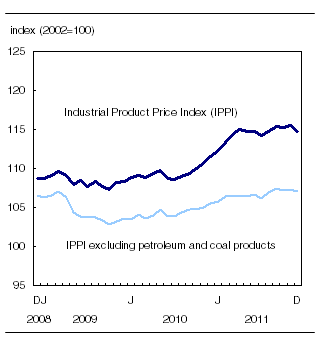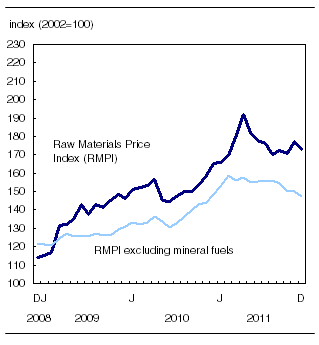Industrial product and raw materials price indexes
Archived Content
Information identified as archived is provided for reference, research or recordkeeping purposes. It is not subject to the Government of Canada Web Standards and has not been altered or updated since it was archived. Please "contact us" to request a format other than those available.
Related subjects
-
[an error occurred while processing this directive]
From November to December, the Industrial Product Price Index (IPPI) declined 0.7% and the Raw Materials Price Index (RMPI) was down 2.4%. These declines were mainly the result of lower petroleum and metals prices.
Prices for industrial goods decline

Chart description: Prices for industrial goods decline
Industrial Product Price Index, monthly change
The IPPI decreased in December after posting a 0.3% increase in November. It was the IPPI's largest decline since the 0.9% decrease in June 2010. The downturn in the index was largely a result of lower prices for petroleum and coal products (-3.7%) and primary metal products (-2.4%). Chemical products also contributed, though to a much lesser extent, with a 0.7% decline.
Note to readers
All data in this release are seasonally unadjusted and usually subject to revision for a period of six months (for example, when the July index is released, the index for the previous January becomes final).
The Industrial Product Price Index (IPPI) reflects the prices that producers in Canada receive as the goods leave the plant gate. It does not reflect what the consumer pays. Unlike the Consumer Price Index, the IPPI excludes indirect taxes and all the costs that occur between the time a good leaves the plant and the time the final user takes possession of it, including transportation, wholesale and retail costs.
Canadian producers export many goods. They often indicate their prices in foreign currencies, especially in US dollars, which are then converted into Canadian dollars. In particular, this is the case for motor vehicles, pulp, paper and wood products. Therefore, a rise or fall in the value of the Canadian dollar against its US counterpart affects the IPPI. But the conversion into Canadian dollars only reflects how respondents provide their prices. Moreover, this is not a measure that takes into account the full effect of exchange rates, since that is a more difficult analytical task.
The conversion of prices received in US dollars is based on the average monthly exchange rate (noon spot rate) established by the Bank of Canada and is available on CANSIM in table 176-0064 (series v37426). Monthly and annual variations in the exchange rate, as described in the text, are calculated according to the indirect quotation of the exchange rate (for example, CAN$1 = US$X).
The Raw Materials Price Index (RMPI) reflects the prices paid by Canadian manufacturers for key raw materials. Many of those prices are set on the world market. However, as few prices are denominated in foreign currencies, their conversion into Canadian dollars has only a minor effect on the calculation of the RMPI.
The decrease in petroleum and coal product prices in December was primarily the result of declines in diesel fuel (-5.2%) and gasoline (-2.8%). North American demand for petroleum products was weaker in December, partly because of milder weather. In addition, high inventories in Organisation for Economic Co-operation and Development countries and excess capacity in oil-producing countries contributed to the decline in oil prices.
Primary metals prices (-2.4%) declined in December for a fourth consecutive month, pulled downward mainly by lower demand for precious metals. Prices decreased for precious metal basic manufactured shapes (-12.7%), gold in primary forms (-4.0%) and silver and platinum (-6.4%). Further price reductions were observed for primary aluminum products (-5.7%) and primary copper products (-6.1%). Aluminum prices were affected by global excess supply, while weaker demand pushed copper prices downward.
Some product groups experienced increases in December, particularly motor vehicles and other transportation equipment, lumber and other wood products, and machinery and equipment, which all rose 0.3%. These price increases were moderated slightly by the 0.2% appreciation of the Canadian dollar relative to the US dollar.
Some Canadian producers who export their products are generally paid on the basis of prices set in US dollars. Consequently, the strength of the Canadian dollar in relation to the US dollar in December had the effect of reducing the corresponding prices in Canadian dollars. Without the impact of the exchange rate, the IPPI would have declined 0.6% instead of 0.7%.
The IPPI excluding petroleum and coal prices products declined 0.3% in December, following a 0.1% increase in November.
12-month change in the Industrial Product Price Index
The IPPI was up 2.8% in December compared with the same month a year earlier. The growth in prices continued to slow for the third straight month since the 5.5% peak in September. Of the 21 major commodity aggregations, 17 were up in December, compared with 19 in October and 18 in November.
Relative to December 2010, the IPPI was pushed upward mainly by higher prices for petroleum and coal products (+12.8%). More moderate contributions were made by chemical products (+4.8%), motor vehicles and other transportation equipment (+2.3%), fruit, vegetables and feeds (+3.2%) and meat, fish and dairy products (+3.1%).
Year over year, the growth of petroleum and coal product prices continued to slow, declining steadily to 12.8% in December. The 2011 high was 31.9% in July.
Similarly, year over year, the IPPI excluding petroleum and coal products increased 1.4% from December 2010. This was a weaker increase than that seen in March (+2.8%), the highest level reached in 2011.
The advance of the IPPI in December relative to the same month a year earlier was moderated by a decrease in primary metal products (-5.2%). This second consecutive decline for this product group was much larger than the 0.8% decrease observed in November. The largest contributors to the decline in metals in December were lower prices for copper and copper alloy products (-15.0%), nickel products (-23.5%) and aluminum products (-8.1%).
In December, the 1.6% year-over-year decline in the value of the Canadian dollar relative to the US dollar had an upward effect on the IPPI. Without the impact of the exchange rate, the IPPI would have risen 2.4% instead of 2.8%.
Raw Materials Price Index, monthly change
In December, the RMPI declined 2.4%, following a 3.8% increase in November. The decline in prices was led by mineral fuels (-3.0%) and non-ferrous metals (-3.3%). Smaller contributions were made by vegetable products (-2.3%) and animals and animal products (-0.8%).
Prices for raw materials decline

Chart description: Prices for raw materials decline
Within mineral fuels, crude oil declined 3.2%, a substantial change from the 8.9% increase in November.
In December, other than lead and nickel concentrates, all non-ferrous metal groups declined, notably copper concentrates (-6.4%) and precious metals (-4.6%).
The main factors in the December price decrease for vegetable products were wheat (-5.9%) and corn (-4.7%). The excess wheat supply in the United States was the result of favourable weather and the high level of seeded acreage. The decline in corn prices was largely a result of weaker demand for feed and biodiesel manufacturing.
The RMPI excluding mineral fuels was down 1.7% in December, a larger decrease than the 0.3% observed in November. This was the fourth consecutive decline of the index.
12-month change in the Raw Materials Price Index
Relative to December 2010, the RMPI rose 4.7%, continuing the slowdown in growth that has prevailed since May (+25.6%), when the index posted its highest growth rate for 2011. The main contributors to the RMPI's year-over-year advance in December were higher prices for mineral fuels (+10.8%) and animals and animal products (+14.5%). The RMPI's increase was moderated by non-ferrous metals (-11.9%), which had a third consecutive decline.
Year over year, the RMPI excluding mineral fuels was down 0.6% in December, its first decrease since the 3.3% decline observed in October 2009.
Available on CANSIM: tables 329-0056 to 329-0068 and 330-0007.
Table 329-0056: Industrial Product Price Index by major commodity aggregations.
Table 329-0057: Industrial Product Price Index by industry.
Table 329-0058: Industrial Product Price Index by stage of processing.
Tables 329-0059 to 329-0068: Industrial Product Price Index by commodity.
Table 330-0007: Raw Materials Price Index by commodity.
Definitions, data sources and methods: survey numbers, including related surveys, 2306 and 2318.
The December 2011 issue of Industry Price Indexes (62-011-X, free) will soon be available.
The industrial product and raw materials price indexes for January will be released on March 1.
For more information, or to enquire about the concepts, methods or data quality of this release, contact Client Services (toll-free 1-888-951-4550; 613-951-4550; fax: 1-855-314-8765 or 613-951-3117; ppd-info-dpp@statcan.gc.ca), Producer Prices Division.
- Date modified:
